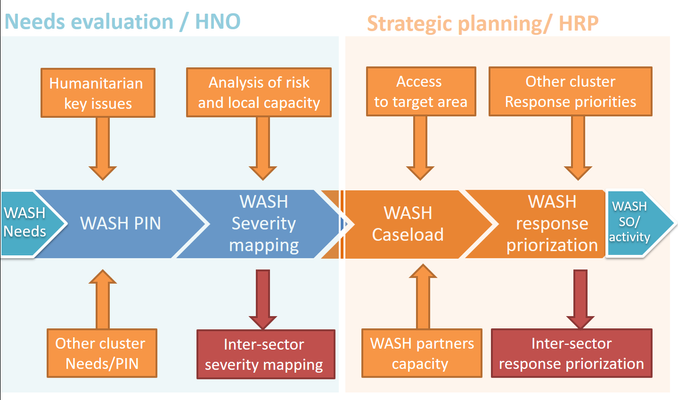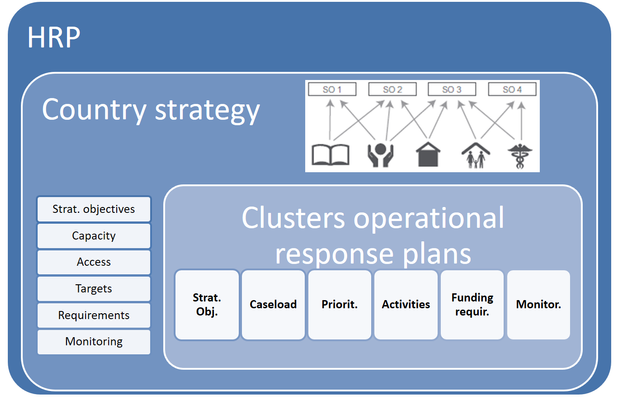| Expand | ||||
|---|---|---|---|---|
| Contribute to the HRP process
| |||
|
| Expand | ||
|---|---|---|
| ||
| Expand | ||
|---|---|---|
| ||
...
Contribute to the Humanitarian Response Plan by developing the WASH Operational Response Plan
The Humanitarian Response Plan (HRP) is the main inter-sector tool for response planning. It includes a summary of the humanitarian situation, the humanitarian country strategy and the
...
Response Operational Plans of each cluster
...
. It also contains the
...
overall response budget, and
...
is used as a funds appeal document.
The HRP process is driven by OCHA, with contributions from each cluster coordinators. In protracted emergencies, it is usually done on a yearly basis, in October, after the Humanitarian Needs Overview (HNO). HRP are
...
sometimes updated 6 months after their publication, with the release of a revised HRP. In sudden onset emergencies,
...
HRP can be replaced or complemented by a Flash Appeal, following a specific emergency scale-up activation timeline.
WASH coordination
...
platforms must participate in the HRP process by working with WASH partners and other clusters
...
to develop or update the WASH Operational Response Plan
...
...
...
. The following sub-pages provides information on how to develop each WASH Operational Response Plan's elements:
| Page Tree | ||
|---|---|---|
|
| Summary steps from needs assessment to strategic planning |
...
| Elements of a Humanitarian Response Plan |
...
Gather WASH lesson-learned doc and operational guidance relevant to the context
Before starting strategic planning process, it is necessary to gather and analyse all available documents relevant to the current crisis and context. The WASH operational website set up by the Coordination platform can play the role of a document library, although this is complicated to maintain during transition from cluster to sector, so information might be lost. Many documents about the country and the context is also usually available at the level of the WASH partners. Such documents can also be attached to the Emergency Preparedness Plan, which is a main source of information for planning the response. The GWC website also have a series of Operational Guidelines that can be relevant to your context (see above section). The list of relevant documents includes previous HNO/HRPs and monitoring reports, which can give you a good estimation of which targets can be realistically set up for the current response.
Define WASH strategic objectives
Definition of WASH strategic objectives should be done collaboratively with the Sectorial Advisory Group (SAG). To respect a coherency in the strategic planning process, primary considerations for definition of these objectives should not necessarily be WASH related, but based on Country Strategic Objectives, Humanitarian key issues and strategic objective of corresponding key clusters
In some contexts, WASH can be considered as a priority cluster (drought, epidemic outbreak), but even in those contexts it might be relevant to consider first Food Security or Health objectives, and align WASH strategic objective on theirs.
Define WASH response strategy
The WASH coordination platform must elaborate the response strategy, defining which activities should be done to answer to the needs in a relevant way. This is a largely qualitative process, that should be done during a meeting with the SAG, based on the partners’ expertise of the and the lesson-learned from former emergency responses.
...
| title | Key guidance and tools |
|---|
...
| title | Field examples |
|---|
...
| (HRP) |

